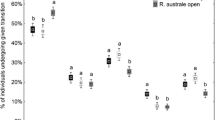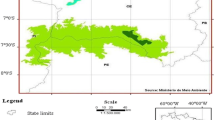Abstract
Effects of Commercial Harvesting on Population Characteristics and Rhizome Yield of Anemone altaica. Commercial harvesting constitutes a direct threat to numerous non–timber forest products (NTFPs), but its ecological effects have not been well documented. Anemone altaica Fisch. ex C. A. Mey, a spring ephemeral plant found in temperate forests of Eurasia, is a traditional Chinese herb. Owing to medicinal value, its rhizomes have been harvested for commercial purposes in northwestern China for many years. This paper addresses the ecological effects of commercial harvesting on A. altaica populations under different harvest intensities. The results show that size–selective harvesting of rhizomes can increase population densities by asexual propagation. Currently, two– to three–year–old individuals derived from asexual propagation are the main targets of commercial harvesting. The increased demand in recent years has resulted in earlier and more intensive harvesting activities largely impacting the natural recovery of the harvested populations. For sustainable use of this traditional medicinal species, we recommend that a periodic harvest strategy of three to four years be adopted.
商业性采集对阿尔泰银莲花种群特征及根状茎产量的影响
对许多非木材林产品而言,商业性采集是导致其受威胁的直接因素之一,但目前商业性采集所产生的生态效应仅在少数植物中开展了一些研究。阿尔泰银莲花是广泛分布在欧洲和亚洲北部的一种早春多年生林下草本植物,其根状茎是一种重要的传统中药。由于其药用价值,阿尔泰银莲花根状茎在中国西北地区已经有多年的采集历史。本文对不同采集强度下商业性采集活动对阿尔泰银莲花的生态学效应进行了研究。 结果表明,选择性采集可以通过影响无性繁殖而增加其种群密度。通过根状茎所产生的个体经过2–3年的生长后,成为目前商业性采集的主要对象。近年来持续上升的市场需求导致采集时间提前、采集强度增加,进而严重影响到阿尔泰银莲花种群的恢复。为了持续利用这一传统药用植物,建议每一采集地可以采取每隔3–4年进行一次采集的间歇式采集方式。





Similar content being viewed by others
Literature Cited
Balick, M. J. and R. Mendelsohn. 1992. Assessing the economic value of traditional medicines from tropical rain forests. Conservation Biology 6:128–130.
Cunningham, A. B. 2001. Applied ethnobotany: People, wild plant use and conservation. Earthscan, London.
Fenberg, P. B. and K. Roy. 2008. Ecological and evolutionary consequences of size–selective harvesting: How much do we know? Molecular Ecology 17(1):209–220.
Ghimire, S. K., D. Mckey, and Y. Aumeeruddy-Thomas. 2005. Conservation of Himalayan medicinal plants: Harvesting patterns and ecology of two threatened species, Nardostachys grandiflora DC. and Neopicrorhiza scrophulariiflora (Pennell) Hong. Biological Conservation 124:463–475.
Guariguata, M. R., J. C. Licona, B. Mostacedo, and P. Cronkleton. 2009. Damage to Brazil nut tree (Bertholletia excelsa) during selective time harvesting in Northern Bolivia. Forest Ecology and Management 258:788–793.
Guttormsen, A. G., D. Kristofersson, and E. Nævdal. 2008. Optimal management of renewable resources with Darwinian selection induced by harvesting. Journal of Environmental Economics and Management 56:167–179.
Hall, P. and K. Bawa. 1993. Methods to assess the impact of extraction of non–timber tropical forest products on plant populations. Economic Botany 47:234–247.
Hamilton, A. and P. Hamilton. 2006. Plant conservation: An ecosystem approach. Earthscan, London.
Koltunov, A., S. L. Ustin, G. P. Asner, and I. Fung. 2009. Selective logging changes forest phenology in the Brazilian Amazon: Evidence from MODIS image time series analysis. Remote Sensing of Environment 113:2431–2440.
Lefèvre, F. 2004. Human impacts on forest genetic resources in the temperate zone: An updated review. Forest Ecology and Management 197:257–271.
Mooney, E. H. and J. B. McGraw. 2009. Relationship between age, size, and reproduction in populations of American ginseng, Panax quinquefolius (Araliaceae), across a range of harvest pressures. Ecoscience 16(1):84–94.
Rendón-Carmona, H., A. Martínez-Yrízar, P. Balvanera, and D. Pérez-Salicrup. 2009. Selective cutting of woody species in a Mexican tropical dry forest: Incompatibility between use and conservation. Forest Ecology and Management 257:567–579.
Salick, J., A. Mejia, and T. Anderson. 1995. Non–timber forest products integrated with natural forest management, Rio San Juan. Nicaragua. Ecological Application 5:878–895.
Schumann, K., R. Wittig, A. Thiombiano, U. Becker, and K. Hahn. 2010. Impact of land–use type and bark– and leaf–harvesting on population structure and fruit production of the baobab tree (Adansonia digitata L.) in a semi–arid savanna, West Africa. Forest Ecology and Management 260:2035–2044.
Ticktin, T. 2004. The ecological implications of harvesting non–timber forest products. Journal of Applied Ecology 41:11–21.
——— and P. Nantel. 2004. Dynamics of harvested populations of the tropical understory herb Aechmea magdalenae in old–growth versus secondary forests. Biological Conservation 120:461–470.
Wang, W. C. 1980. Page 12 Flora of China. Vol. 28. Science Press, Beijing.
Wang, Y. M. 2008. Analysis of market demand tendency of Anemone altaica. National Information of Medica Materials 6(15):4.
Williams, V. L., K. Balkwill, and E. T. F. Witkowski. 2000. Unraveling the commercial market for medicinal plants and plant parts on the Witwatersrand, South Africa. Economic Botany 54(3):310–327.
Wu, J., Y. Zhang, and S. Li. 1990. Preliminary report on geographical distribution and ontogeny of Anemone altaica. Northwest Pharmaceutical Journal 5(2):32–34.
Wu, Z. Y., T. Y. Zhou, and P. G. Xiao. 1988. Compendium of Xinhua Herbal, Vol. (I). Shanghai: Shanghai Science and Technology Publishing House (in Chinese).
Zhu, A. P. 2009. Market analysis of Anemone altaica in 2009 and future prospect. National Information of Medica Materials 7(15):10–11.
Acknowledgments
Professor Cunxu Wei helped to prepare the photographs. Many thanks to Ms. Niccy Aitken for assisting with the English. This study was financially supported by a grant from the National Natural Science Foundation of China (30970285) and Jiangsu Overseas Research and Training Program for University Prominent Young and Middle–aged Teachers and Presidents.
Author information
Authors and Affiliations
Corresponding author
Rights and permissions
About this article
Cite this article
Huai, H., Wen, G., Xu, W. et al. Effects of Commercial Harvesting on Population Characteristics and Rhizome Yield of Anemone altaica . Econ Bot 67, 41–50 (2013). https://doi.org/10.1007/s12231-013-9224-9
Received:
Accepted:
Published:
Issue Date:
DOI: https://doi.org/10.1007/s12231-013-9224-9




